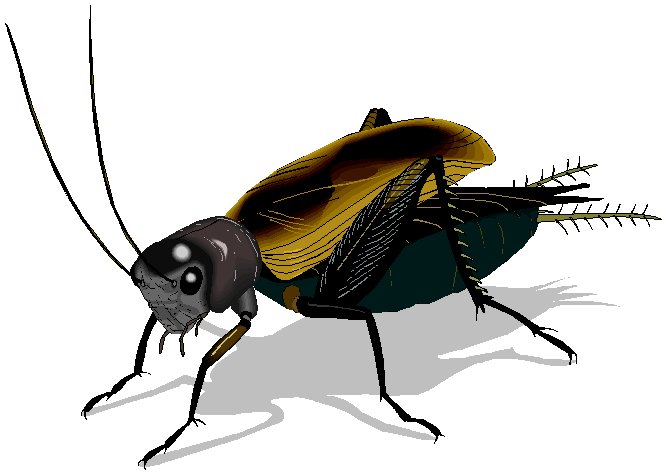LEARNING OBJECTIVES OF SECTION
After completing this section students should be able to:
- Describe the general internal structures of an insect.
- Describe the general structure of the insect respiratory system and explain how it differs from that of humans in both structure and function.
- Describe the circulatory system of insects and explain how it differs from that of humans in both structure and function.
- Describe the basic structures and function of the insect excretory system.
- Describe the similarities of the insect and human reproductive system.
- Describe the general nervous system of insects and explain how it differs from that of humans in structure and function.
Terms: hearts, aorta, ostia, plasma, hemolymph, spiracle, trachea, taenida, respiratory plastron, fat body, peritrophic membrane, foregut, midgut, hindgut, brain, synapse, protocerebrum, tritocerebrum, deutocerebrum, subesophageal ganglion, ventral nerve cord, malpighian tubules, ecdysis, metamorphosis, juvenile hormone, ecdysone, brain hormone, oviparous, viviparous, ovoviviparous, spermatheca, spermatophore, parthenogensis, hermaphrodite.
- A. Internal Anatomy Structure.
- 1. Circulation.
- a. Organization.
- (1) Humans--closed.
- (2) Insects--open.
- b. Structures.
- (1) Hearts--Ostia.
- (2) Aorta.
- c. Efficiency.
- d. Functions.
- (1) Transport.
- (2) Protection.
- (3) Hydraulic.
- (4) Respiration (minor).
- (5) Thermoregulation.
- e. Blood characteristics.
- (1) Color.
- (2) Contents.
- 2. Digestive system.
- a. Foregut (exoskeletal).
- (1) Conducts, stores, guides foods.
- b. Midgut (mesodermal).
- (1) Major absorption.
- (2) Enzyme production.
- c. Hindgut (exoskeletal).
- (1) Transports waste from body.
- (2) Reabsorbs water, salt.
- d. Salivary glands.
- (1) Food solvent.
- (2) Digestive enzymes.
- (3) Produce glue, silk (saliva, of course).
- e. Digestive process.
- (1) Intestinal.
- (2) Extra-intestinal.
- (3) Microbial aids.
- 3. Excretory System.
- a. Function: Maintain environment suitable for survival.
- (1) Elimination of waste.
- (2) Regulation of salt and water.
- b. Malpighian tubules.
- c. Hind gut.
- 4. Ventilation.
- a. Tracheal System.
- (1) Spiracles.
- (2) Tracheae.
- (3) Air sacs.
- (4) Taenida.
- b. Mode of action.
- (1) Diffusion.
- (2) Pumps.
- c. Efficiency.
- (1) Aquatic Adaptations for Respiration.
- 5. Nervous System. Brain and ventral nerve cord.
- a. Brain
- (1) Role: Receive, integrate sensory data (little coordination).
- • Protocerebrum.
- • Deutocerebrum.
- • Tritocerebrum.
- b. Ventral nerve cord and ganglia.
- (1) Subesophageal ganglia.
- (2) Thoracic ganglia.
- (3) Abdominal ganglia.
| Return to Table of Contents |  |
Section IV Continued
- B. Life Support Systems
- 1. Growth
- a. Exoskeleton limits growth.
- b. Shedding exoskeleton (ecdysis) necessary.
- c. Ecdysis involves loss of:
- (1) Outside body covering.
- (2) Foregut
- (3) Hindgut
- (4) Respiratory system.
- 2. Metamorphosis. Regulated by juvenile hormone and Ecdysone.
- a. Types of Metamorphosis.
- (1) Simple, (silverfish). Ametabola
- (2) Gradual ( grasshoppers.) Paurametabola
- (3) Complete ( flies.) Holometabola
- 3. Reproduction. Insects sexual structures:
| Males: | | Females: |
| testis | | ovaries |
| vas deferens | | ovarioles |
| seminal vesicle | | spermatheca |
| accessory glands | | spermatheca gland |
| penis (adaegus) | | oviduct |
| spermatophore | | vagina |
MOST INSECTS REPRODUCE SEXUALLY.
Eggs deposited at various stages.
• Oviparous (most insects) lay undeveloped eggs.
• Ovoviparous ( aphids) eggs develop and hatch inside female, escape
immediately.
• Viviparous (Tsetse flies) egg hatches inside female, nourished by
pseudoplacenta, or on female.
Exceptions to normal reproduction.
• Parthenogenesis,
• Hermaphrodism
STUDY QUESTIONS
- What are the basic structures of the insect respiratory system. Compare those structures to the ones found in the human respiratory system.
- What is the role of the insect circulatory system in respiration?
- List the components of the insect circulatory system. How does its' efficiency compare to that of humans?
- What are the basic structures of the insect excretory system? What would you call the insect "liver"?
- What is the basic function of the insect "brain"? Why doesn't an insect die immediately when you cut off its head?
- What part of the insect nervous system do you think controls the courtship behavior?
- What insect hormone cause the molting process to be initiated?
- What is the technical name of the "molting" hormone?
- What is parthenogenetic reproduction? Name one insect group that uses this approach.
- What is the function of the spermatheca? In what sex is it found?
Go to Section V - Insect Senses
<< back

